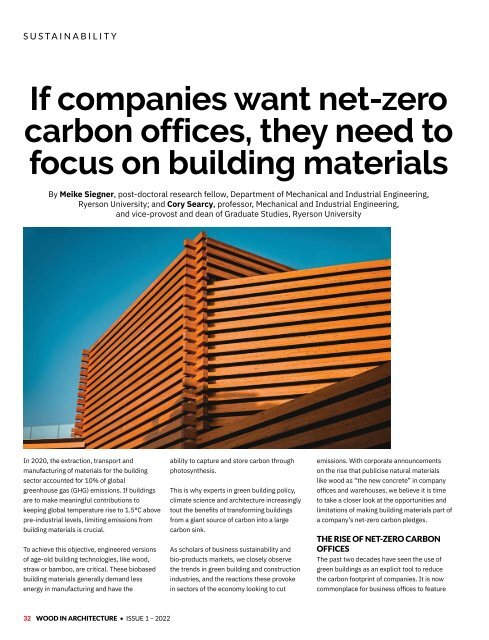Wood In Architecture Issue 1, 2022
First published in 2017, Wood in Architecture (WIA) is a bi-annual trade magazine devoted to the international timber construction sector. The newest addition to the Panels & Furniture Group of wood magazines, WIA features in-depth insights to the latest industry news, incredible projects and leading trade events. WIA is an advocate for timber as a material of choice for today’s built environment, and is the perfect source of inspiration for architects, builders, engineers and interior designers across the globe.
First published in 2017, Wood in Architecture (WIA) is a bi-annual trade magazine devoted to the international timber construction sector. The newest addition to the Panels & Furniture Group of wood magazines, WIA features in-depth insights to the latest industry news, incredible projects and leading trade events. WIA is an advocate for timber as a material of choice for today’s built environment, and is the perfect source of inspiration for architects, builders, engineers and interior designers across the globe.
Create successful ePaper yourself
Turn your PDF publications into a flip-book with our unique Google optimized e-Paper software.
SUSTAINABILITY<br />
If companies want net-zero<br />
carbon offices, they need to<br />
focus on building materials<br />
By Meike Siegner, post-doctoral research fellow, Department of Mechanical and <strong>In</strong>dustrial Engineering,<br />
Ryerson University; and Cory Searcy, professor, Mechanical and <strong>In</strong>dustrial Engineering,<br />
and vice-provost and dean of Graduate Studies, Ryerson University<br />
<strong>In</strong> 2020, the extraction, transport and<br />
manufacturing of materials for the building<br />
sector accounted for 10% of global<br />
greenhouse gas (GHG) emissions. If buildings<br />
are to make meaningful contributions to<br />
keeping global temperature rise to 1.5°C above<br />
pre-industrial levels, limiting emissions from<br />
building materials is crucial.<br />
To achieve this objective, engineered versions<br />
of age-old building technologies, like wood,<br />
straw or bamboo, are critical. These biobased<br />
building materials generally demand less<br />
energy in manufacturing and have the<br />
ability to capture and store carbon through<br />
photosynthesis.<br />
This is why experts in green building policy,<br />
climate science and architecture increasingly<br />
tout the benefits of transforming buildings<br />
from a giant source of carbon into a large<br />
carbon sink.<br />
As scholars of business sustainability and<br />
bio-products markets, we closely observe<br />
the trends in green building and construction<br />
industries, and the reactions these provoke<br />
in sectors of the economy looking to cut<br />
emissions. With corporate announcements<br />
on the rise that publicise natural materials<br />
like wood as “the new concrete” in company<br />
offices and warehouses, we believe it is time<br />
to take a closer look at the opportunities and<br />
limitations of making building materials part of<br />
a company’s net-zero carbon pledges.<br />
THE RISE OF NET-ZERO CARBON<br />
OFFICES<br />
The past two decades have seen the use of<br />
green buildings as an explicit tool to reduce<br />
the carbon footprint of companies. It is now<br />
commonplace for business offices to feature<br />
32 WOOD IN ARCHITECTURE • ISSUE 1 – <strong>2022</strong>


















